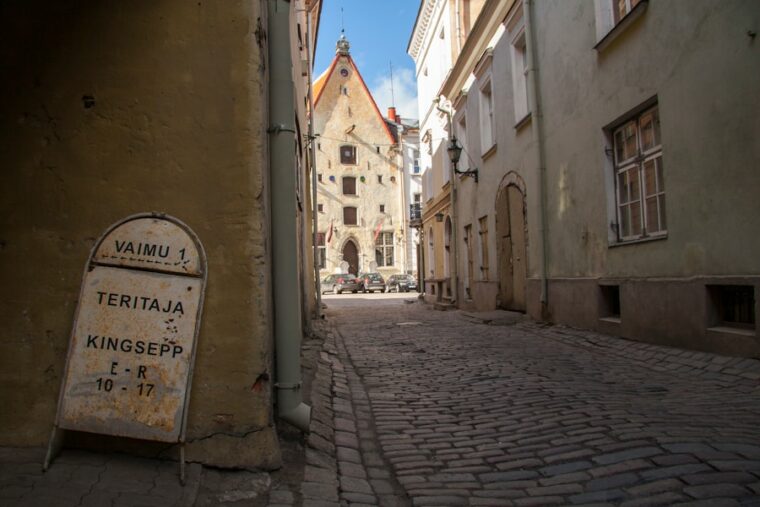Estonia is home to some of the most charming and well-preserved medieval towns in Europe. Walking through the cobblestone streets of Tallinn, the capital city, feels like stepping back in time. The city’s Old Town is a UNESCO World Heritage site, with its medieval walls, narrow alleyways, and well-preserved buildings dating back to the 13th century. The town square, Raekoja plats, is a bustling hub of activity, surrounded by colorful merchant houses and the iconic Town Hall. Visitors can also explore the medieval Toompea Castle, which offers stunning views of the city and the Baltic Sea.
In addition to Tallinn, Estonia is home to several other medieval towns that are worth exploring. The town of Tartu, known for its prestigious university and vibrant cultural scene, boasts a well-preserved Old Town with charming wooden houses and historic buildings. The town of Kuressaare, located on the island of Saaremaa, is home to a medieval castle and a picturesque town center. Exploring these medieval towns offers visitors a unique glimpse into Estonia’s rich history and architectural heritage.
Estonia’s medieval towns are not only visually stunning, but they also offer a wealth of cultural and historical experiences. From exploring ancient castles to wandering through centuries-old streets, visitors to Estonia’s medieval towns are sure to be captivated by the charm and beauty of these historic destinations.
Exploring Estonia’s Rich History
Estonia’s rich history is evident in its diverse array of historical sites and landmarks. From ancient stone fortresses to Soviet-era relics, the country’s history is a fascinating tapestry of different eras and influences. One of the most iconic historical sites in Estonia is the ancient settlement of Otepää, which dates back to the 6th century. This area is known for its well-preserved hill forts and ancient burial mounds, offering visitors a glimpse into Estonia’s prehistoric past.
The country’s more recent history is also on display in its numerous museums and cultural institutions. The Estonian History Museum in Tallinn offers a comprehensive look at the country’s history, from its early settlements to its modern-day independence. The museum’s exhibits include artifacts from the Viking era, medieval times, and the Soviet occupation, providing a thorough overview of Estonia’s complex past.
In addition to its historical sites and museums, Estonia also boasts a number of well-preserved manor houses and palaces that offer a glimpse into the country’s aristocratic past. The Palmse Manor, located in Lahemaa National Park, is a prime example of Estonia’s elegant manor houses, with its beautifully landscaped gardens and opulent interiors. Exploring Estonia’s rich history offers visitors a deeper understanding of the country’s cultural heritage and the forces that have shaped its identity.
Natural Wonders of Estonia
Estonia is a country of breathtaking natural beauty, with diverse landscapes that range from pristine forests to picturesque coastal areas. One of the most stunning natural wonders in Estonia is Soomaa National Park, known as the “Land of Bogs.” This unique park is home to vast wetlands, ancient forests, and meandering rivers, offering visitors the chance to explore untouched wilderness and observe a wide variety of flora and fauna.
Another natural wonder in Estonia is the Lahemaa National Park, which is the largest national park in the country. This park is home to diverse ecosystems, including coastal areas, forests, and wetlands, as well as numerous historical sites such as ancient fishing villages and well-preserved manor houses. Visitors can explore the park’s extensive network of hiking trails, which lead through some of Estonia’s most stunning natural landscapes.
Estonia’s natural wonders also extend to its coastline, which is dotted with picturesque beaches and charming seaside towns. The coastal cliffs of Paldiski offer breathtaking views of the Baltic Sea, while the resort town of Pärnu boasts sandy beaches and a lively seaside promenade. Whether exploring the country’s inland wilderness or its coastal areas, visitors to Estonia are sure to be captivated by its natural beauty.
Discovering Estonia’s Unique Culture
Estonia’s unique culture is a blend of influences from its Nordic neighbors, as well as its own distinct traditions and customs. One of the most iconic aspects of Estonian culture is its folk music and dance traditions. The country is home to numerous folk festivals and events where visitors can experience traditional music and dance performances, as well as participate in workshops and demonstrations.
In addition to its folk traditions, Estonia also has a thriving contemporary arts scene, with numerous galleries and art spaces showcasing the work of local artists. The Kumu Art Museum in Tallinn is one of the country’s premier art institutions, featuring an extensive collection of Estonian art from the 18th century to the present day. The museum also hosts temporary exhibitions that highlight contemporary art trends in Estonia and beyond.
Estonia’s unique culture is also evident in its traditional crafts and artisanal products. Visitors can explore local markets and workshops to discover handmade textiles, ceramics, and woodwork that showcase the country’s rich craft traditions. Whether experiencing traditional folk arts or contemporary cultural expressions, visitors to Estonia are sure to be inspired by the country’s vibrant and diverse cultural scene.
The Culinary Delights of Estonia
Estonia’s culinary scene is a delightful blend of traditional flavors and modern innovations, with an emphasis on fresh, locally sourced ingredients. One of the most iconic dishes in Estonian cuisine is black bread, which has been a staple in the country for centuries. Visitors can sample this hearty bread at local bakeries and markets, where it is often served with butter or topped with smoked fish or cheese.
Another must-try dish in Estonia is kama, a traditional Estonian porridge made from roasted barley, rye, oat, and pea flour. This nutritious dish is often served with milk or kefir and sweetened with honey or sugar, offering visitors a taste of authentic Estonian comfort food. In addition to these traditional dishes, Estonia’s culinary scene also features a wide variety of seafood dishes, thanks to the country’s extensive coastline.
Estonia’s culinary scene also includes a growing number of innovative restaurants that are reinterpreting traditional flavors with modern techniques. The country’s capital city, Tallinn, is home to numerous fine dining establishments that showcase Estonian cuisine in creative and sophisticated ways. Whether sampling traditional dishes or contemporary culinary creations, visitors to Estonia are sure to be impressed by the country’s diverse and delicious food offerings.
Adventure and Outdoor Activities in Estonia
Estonia’s diverse landscapes provide ample opportunities for outdoor adventure and exploration. The country’s extensive network of hiking trails offers visitors the chance to discover its pristine wilderness areas, from dense forests to coastal marshes. One popular hiking destination is the Viru bog trail in Lahemaa National Park, which leads through a picturesque wetland area with wooden boardwalks that allow visitors to explore this unique ecosystem.
In addition to hiking, Estonia also offers a wide range of water-based activities along its coastline and inland waterways. Visitors can enjoy kayaking or canoeing on the country’s rivers and lakes, or take a boat trip along the picturesque coastline. The island of Saaremaa is a popular destination for sailing enthusiasts, with its sheltered bays and scenic harbors providing ideal conditions for exploring the Baltic Sea.
For those seeking more adrenaline-fueled activities, Estonia also offers opportunities for rock climbing, mountain biking, and even winter sports such as cross-country skiing and ice skating. Whether exploring the country’s natural landscapes on foot or by water, or seeking more adventurous pursuits, visitors to Estonia are sure to find plenty of opportunities for outdoor excitement.
Planning Your Visit to Estonia
When planning a visit to Estonia, there are several practical considerations to keep in mind. The best time to visit the country is during the summer months, when the weather is warm and daylight hours are long. However, visitors should be prepared for changeable weather conditions at any time of year, so it’s important to pack layers and waterproof clothing.
In terms of transportation, Estonia has a well-developed network of public buses and trains that connect major cities and towns. Renting a car is also a popular option for exploring more remote areas or traveling at your own pace. For those looking to explore Estonia’s islands or coastal areas, ferries provide regular connections between the mainland and various island destinations.
Accommodation options in Estonia range from budget-friendly hostels and guesthouses to luxury hotels and spa resorts. Visitors can choose from a wide variety of accommodations in both urban and rural areas, depending on their preferences and travel itinerary. When it comes to dining options, Estonia offers a diverse range of restaurants and cafes serving traditional Estonian cuisine as well as international fare.
In conclusion, Estonia offers visitors a wealth of experiences that encompass its rich history, natural beauty, unique culture, delicious cuisine, and outdoor adventure opportunities. Whether exploring medieval towns or pristine wilderness areas, sampling traditional dishes or embarking on outdoor activities, visitors to Estonia are sure to be captivated by this enchanting Baltic gem. With careful planning and an open mind, a visit to Estonia promises unforgettable memories and experiences that will leave a lasting impression.


